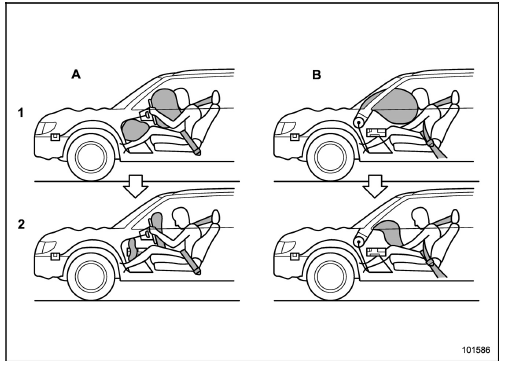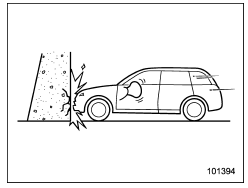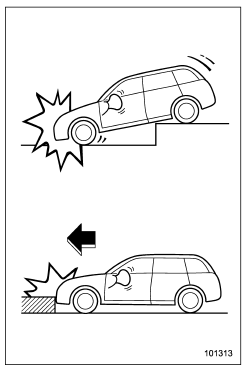Subaru Crosstrek Owners Manual: Operation

- Driver's side
- Passenger's side
- SRS AIRBAGs deploy as soon as a collision occurs.
- After deployment, SRS AIRBAGs start to deflate immediately so that the driver's vision is not obstructed.
The SRS airbags can function only when the ignition switch is in the "ON" position.
The SUBARU advanced frontal airbag system is designed to determine the activation or deactivation condition of the front passenger's SRS frontal airbag depending on the characteristic of item (s) or person on the front passenger's seat monitored by the front passenger's occupant detection system sensor. For this reason, only the driver's SRS frontal airbag may deploy in the event of a collision, but this does not mean failure of the system.
If the following sensors detect a predetermined amount of force during a frontal collision, the control module sends signals to the airbag module(s) (only driver's module or both driver's and front passenger's modules) instructing the module(s) to inflate the SRS frontal airbag(s).
- the front sub sensors
- the impact sensors in the airbag control module
On the driver's side, the SRS knee airbag also inflates with the SRS frontal airbag.
The driver's and front passenger's SRS frontal airbags use dual stage inflators.
The two inflators of each airbag are triggered either sequentially or simultaneously, depending on the severity of impact, in the case of the driver's SRS frontal airbag and depending on the severity of impact and the characteristic of item(s) or person on the seat in the case of the front passenger's SRS frontal airbag.
After deployment, the SRS airbag immediately starts to deflate so that the driver's vision is not obstructed and the driver's ability to maintain control of the vehicle is not impaired. The time required from detecting impact to the deflation of the SRS airbag after deployment is shorter than the blink of an eye.
Both when only the driver's SRS frontal airbag deploys and the driver's and front passenger's SRS frontal airbags deploy, the driver's and front passenger's seatbelt pretensioners operate at the same time.
When the SRS airbag deploys, a sudden, fairly loud inflation noise will be heard and some smoke will be released. These occurrences are a normal result of the deployment. This smoke does not indicate a fire in the vehicle.
CAUTION
Do not touch the SRS airbag system components around the steering wheel and dashboard with bare hands right after deployment. Doing so can cause burns because the components can be very hot as a result of deployment.
The driver's SRS frontal airbag and front passenger's SRS frontal airbag are designed as follows.
- to deploy in the event of an accident involving a moderate to severe frontal collision
- to function on a one-time-only basis
The driver's SRS frontal airbag and front passenger's SRS frontal airbag are not designed as follows.
- to deploy in most lesser frontal impacts* 1
- to deploy in most side or rear impacts or in most roll-over accidents*2
*1: Because the necessary protection can be achieved by the seatbelt alone.
*2: Because deployment of only the driver's SRS frontal airbag or both the driver's and front passenger's SRS frontal airbags would not protect the occupant in those situations.
SRS airbag deployment depends on the level of force experienced in the passenger compartment during a collision. That level differs from one type of collision to another, and it may have no bearing on the visible damage done to the vehicle itself.
Example of accident in which the driver's/driver's and front passenger's SRS frontal airbag(s) will most likely deploy

A head-on collision against a thick concrete wall at a vehicle speed of 12 to 19 mph (20 to 30 km/h) or higher activates only the driver's SRS frontal airbag or both driver's and front passenger's SRS frontal airbags. The airbag(s) will also be activated when the vehicle is exposed to a frontal impact similar in fashion and magnitude to the collision described above.
Examples of the types of accidents in which it is possible that the driver's/driver's and front passenger's SRS frontal airbag(s) will deploy

Only the driver's SRS frontal airbag or both driver's and front passenger's SRS frontal airbags may be activated when the vehicle sustains a hard impact in the undercarriage area from the road surface (such as when the vehicle plunges into a deep ditch, is severely impacted or knocked hard against an obstacle on the road such as a curb).
Examples of the types of accidents in which deployment of the driver's/ driver's and front passenger's SRS frontal airbag(s) is unlikely to occur

- The vehicle strikes an object, such as a telephone pole or sign pole.
- The vehicle slides under the load bed of a truck.
- The vehicle sustains an oblique offset frontal impact.
- The vehicle sustains an offset frontal collision.
- The vehicle strikes an object that can move or deform, such as a parked vehicle.
There are many types of collisions which might not necessarily require deployment of driver's/driver's and front passenger's SRS frontal airbag(s). In the event of accidents like those illustrated, the driver's/ driver's and front passenger's SRS frontal airbag(s) may not deploy depending on the level of accident forces involved.
Examples of the types of accidents in which the driver's/driver's and front passenger's SRS frontal airbag(s) are not designed to deploy in most cases

The driver's and front passenger's SRS frontal airbags are not designed to deploy in most of the following cases.
- If the vehicle is struck from the side or from behind
- If the vehicle rolls onto its side or roof
- If the vehicle is involved in a low-speed frontal collision

- First impact
- Second impact
In an accident where the vehicle is impacted more than once, the driver's and/or front passenger's SRS frontal airbag(s) will deploy only once on the first impact.
Example: In the case of a double collision, first with another vehicle, then against a concrete wall in immediate succession, once either or both of the driver's and front passenger's SRS frontal airbags is/are activated on the first impact, it/they will not be activated on the second impact.
 How to contact the vehicle manufacturer
concerning modifications
for persons with disabilities that
may affect the advanced airbag
system
How to contact the vehicle manufacturer
concerning modifications
for persons with disabilities that
may affect the advanced airbag
system
Changing or moving any parts of the front
seats, rear seat, seatbelts, front bumper,
front side frame, radiator panel, instrument
panel, combination meter, steering wheel,
steering column, tire, s ...
 SRS side airbag and SRS curtain airbag
SRS side airbag and SRS curtain airbag
The SRS side airbag is stored in the door
side of each front seat seatback, which
bears an "SRS AIRBAG" label.
In a moderate to severe side impact
collision, the SRS side airbag on the
impact ...
Other materials:
Dtc b278d id code box judgment circuit
KEYLESS ACCESS WITH PUSH BUTTON START SYSTEM (DIAGNOSTICS) > Diagnostic Procedure with Diagnostic Trouble Code (DTC)DTC B278D ID CODE BOX JUDGMENT CIRCUITDTC detecting condition:• When ID code box setting is set to OFF, ID code box ON input is detected.• When ID code box setting is se ...
Removal
SECURITY AND LOCKS > Remote OpenersREMOVAL1. FRONT HOOD OPENER1. Remove the opener handle.(1) Remove the cable.(2) Remove the bolt, and remove the opener handle.2. After removing the following parts, attach a string to the end of the cable - front hood and remove the cable clip and the cable.&bul ...
Outgoing screen
Outgoing call screen
Open the "Options" screen. Refer to
"Phone volume settings"
Abort the call. The screen returns to
the phone (menu) screen. This is the
same as pressing the on hook switch
on the steering wheel.
NOTE
Depending on the type of Bluetooth
phone being connec ...
